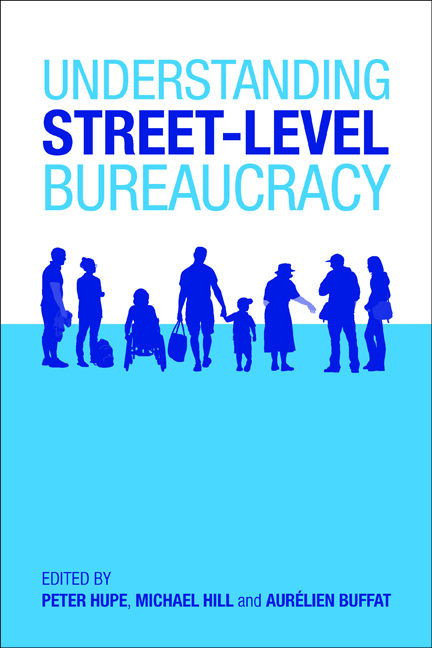Book contents
- Frontmatter
- Contents
- Biographical notes
- Preface
- Part One Introduction
- Part Two Delivering services and benefits: street-level bureaucracy and the welfare state
- Part Three Agents of the state: street-level bureaucracy and law enforcement
- Part Four Embedded in society: street-level bureaucrats as public actors
- Part Five The management of street-level bureaucrats
- Part Six The promise of professionalism
- Part Seven Conclusion
- References
- Index
One - Introduction:defining and understanding street-level bureaucracy
Published online by Cambridge University Press: 08 March 2022
- Frontmatter
- Contents
- Biographical notes
- Preface
- Part One Introduction
- Part Two Delivering services and benefits: street-level bureaucracy and the welfare state
- Part Three Agents of the state: street-level bureaucracy and law enforcement
- Part Four Embedded in society: street-level bureaucrats as public actors
- Part Five The management of street-level bureaucrats
- Part Six The promise of professionalism
- Part Seven Conclusion
- References
- Index
Summary
What is street-level bureaucracy?
The expression ‘street-level bureaucracy’ was coined, as far as we know, by Michael Lipsky. He introduced it in an article in 1971 and elaborated it in a book in 1980, which he further updated in 2010 (Lipsky, 2010). Most of the contributors to this volume make reference to the book, which is cited as the 2010 edition unless they have specifically quoted from the earlier one. In developing an identifiable view, Jeffrey Prottas (1979) and Richard Weatherly (1979) were collaborators. The introduction of the term obviously caught the imagination of many writers on public policy, including ourselves. Consequentially, here, we explore the ‘state of the art’ – which is the aim of this edited volume.
Two observations can be made head on. One is that the essential phenomena that Michael Lipsky asked attention to be paid to have been described in many ways other than in terms of ‘street-level bureaucracy’. For example, here, we may note references to the ‘point of entry’ (Hall, 1974) and the ‘public encounter’ (Goodsell, 1981). Hence, if we were to engage in a computerised literature search with ‘street-level bureaucracy’ as the key term, we would certainly seriously undercount.
A second, and closely related, observation regards the fact that Michael Lipsky's contribution focuses particularly on certain aspects of street-level work and highlights particular problems associated with it. In so doing, he seems to be reluctant to apply his approach to all relevant public sector interfaces. In the new preface written for the 2010 edition of the book, he justifies the book as ‘a search for the place of the individual in those services I call street-level bureaucracies’ (Lipsky, 2010, p xi). Interactions with street-level bureaucracies are ‘places where citizens experience directly the government they have implicitly constructed’ (Lipsky, 2010, p xi).
Lipsky distinguishes two ways to understand the term ‘street-level bureaucrat’. The first one is to equate it with ‘the public services with which citizens typically interact. In this sense, all teachers, police officers, and social workers in public agencies are street-level bureaucrats without further qualification’ (Lipsky, 2010, p xvii). In the second definition – the one originally intended, Lipsky adds – street-level bureaucracy stands for ‘public service employment of a certain sort, performed under certain conditions.… Street-level bureaucrats interact with citizens in the course of the job and have discretion in exercising authority’ (Lipsky, 2010, p xvii).
- Type
- Chapter
- Information
- Understanding Street-Level Bureaucracy , pp. 3 - 24Publisher: Bristol University PressPrint publication year: 2015
- 2
- Cited by



